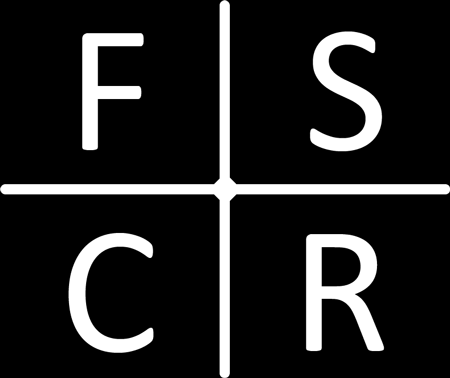‘Sleep is for wimps!’ ‘If you snooze, you lose!’
Both these sentiments appear to accurately reflect the value that the majority of us place upon sleep. This disregard for sleep can be largely attributed to societal influences such as being at work or in education for a set period of time, advances in technology such as transport and electronic devices as well as the daily pressures of social media and demanding work schedules.
However, a lack of sleep should not be taken lightly. As Matthew Walker explains in his book ‘why we sleep’ (1) a lack of sleep can affect all major physiological systems of the body; cardiovascular, metabolic, immune and reproductive as well as having a huge influence on our psychological well-being.
To purchase “Why We Sleep” by Matthew Walker click on this link https://footballscr.com//product/why-we-sleep/
In elite sport we are always looking for the small things that can improve our performance. Focusing too much on these ‘marginal gains’ can often make us forget about the basics. After reading Matthew Walker’s book I firmly believe that sleep is an area that many players can make great strides in their performance without changing too much to their current programme. Therefore, the following blog attempts to give you the science behind sleep which will help you deal with many of the issues the modern player is confronted with.
The distribution of time across 24 hours that we are awake or in a sleep state is known as our ‘Recycle Rate’ and is generally broken down as ~16 hours of wakefulness and ~8 hours asleep. It is our internal body clock (AKA Circadian Rhythm) that primarily regulates this process through the suprachiasmic nucleus. The suprachiasmic nucleus is located about eye-level deep in the brain and is sensitive to various signals that when consistently present can help keep our body clock in check. The strongest signal it responds to is light, yet it can also respond to temperature changes. When light is low in the evening the suprachiasmic nucleus senses this and triggers the release of the hormone Melatonin (AKA Vampire Hormone) which is the signal for us to go to sleep. Conversely, in the presence of light, melatonin is suppressed and in turn our body responds by placing us in an active awake state.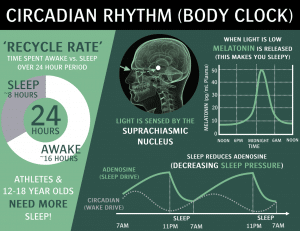
The increase in exposure of artificial light from our screens and monitors presents a considerable problem for our circadian rhythm. The blue light (LED’s) emitted from our smartphones and laptops operate on short wavelengths which is the very same source that our suprachiasmic nucleus recognises as natural day-time light. Therefore, exposure to blue light in the evenings (after the sun has set) can delay the release of melatonin and in turn prevent you from wanting to go to sleep. A study compared reading a book on an i-pad compared to a printed version. During the i-pad condition melatonin release was blocked by 50% and its rise was delayed by three hours. Therefore, to create a favourable sleeping environment, we should avoid having a TV in the bedroom and taper the use of devices with blue light in the hours leading up to bedtime. More recently, newer devices have an in built ‘nightlight’ or ‘night shift’ mode which reduces the brightness of the screen and filters out the blue light. This setting also has the benefit of being able to be programmed to come on automatically at specified times in the day. For example, 8 pm to 8 am would be a suitable period to adopt across all of your devices.
Another factor that can mess with our body clock is travelling across different time zones, manifesting as the dreaded jet-lag (AKA Circadian Desynchronosis). Overcoming jet-lag requires an acclimatisation to a new recycle rate where the sleep and wakefulness periods are re-adjusted. This process is inherently very slow because the suprachiasmic nucleus can only adjust to the change in light signal by 1 hour per day. Therefore, an eight hour flight would require a minimum of eight days to fully adjust to. This can present huge complications for sports teams especially when travelling great distances for tours during pre-season or for competitions as jet lag can result in insomnia, fragmented sleep, impair physical performance (especially endurance), loss of appetite, headaches and gastro-intestinal disturbances. Therefore, in the build up to travelling players should look to adjust their body clock gradually even before getting to the new time zone. Similarly, allowing for a buffer period prior to the first training/competitive matches should be considered.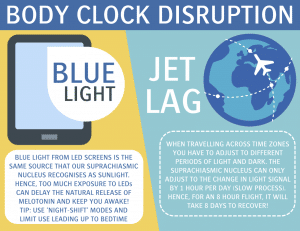
Interestingly circadian rhythms can vary between individuals mainly due to our genetics but also partly due to the stage of our lives we are at (2). Specifically, children are driven to retreat to bed earlier (~9 pm) than adults (~10-11 pm) whilst adolescents are delayed further still (~11 pm-1 am). This variance is known as your ‘Chronotype’ and more easily understood when referring to someone being a ‘morning lark’ or a ‘night owl.’ Regardless of your chronotype, eight hours of sleep per night is still recommended for optimum health in adults (3). There is a very rare condition which permits certain individuals to survive off six hours of sleep per night; however, the statistics suggest you are more likely to be struck by lightning than fall into this category!
Unfortunately, for many night owls, the majority of training schedules revolve around early starts which cut short their opportunity to get in the appropriate amount of sleep. Evidence suggests that when a night owl is forced to wake up too early, their pre-frontal cortex (the region of the brain that controls high level thoughts) remains disabled in a sleep state. Consequently, they cannot function as well until this region warms up. With this in mind, it may be prudent for team managers to re-think their early morning training schedules and delay them by a couple of hours.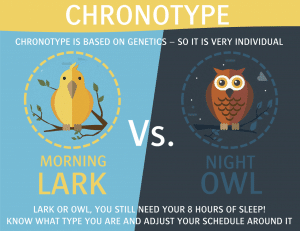 The circadian rhythm is supported by a separate mechanism that assists in our sleep-wake cycle. From the instant we wake up there is a gradual build-up of a chemical known as adenosine which binds to certain receptors in the brain. As the day progresses there is an accumulation of adenosine until it reaches a critical level driving us to sleep. The process of sleep results in a breakdown of this chemical and in turn the ‘Sleep Pressure’ is reduced to evoke a state of alertness upon waking.
The circadian rhythm is supported by a separate mechanism that assists in our sleep-wake cycle. From the instant we wake up there is a gradual build-up of a chemical known as adenosine which binds to certain receptors in the brain. As the day progresses there is an accumulation of adenosine until it reaches a critical level driving us to sleep. The process of sleep results in a breakdown of this chemical and in turn the ‘Sleep Pressure’ is reduced to evoke a state of alertness upon waking.
It is through this pathway that caffeine can interfere with our sleep cycle. Specifically, caffeine is able to bind to the receptors in the brain that adenosine attach to, preventing the build-up of sleep pressure and making you feel less tired. From a performance perspective this may be beneficial as it gives us a heightened level of alertness which can improve performance. However, we need to be careful of the timing of our caffeine ingestion as it will have a negative effect on our performance later down the line in the form of poor sleep. Caffeine has a half-life of five to seven hours which means that it takes this time for the enzymes in your liver to process just half of the caffeine you ingest. Hence, a late afternoon or post dinner coffee will remain in your system until the early hours of the morning and, even if you succeed in getting to sleep earlier, the sleep will be fragmented. Interestingly, de-caffeinated sources still contain ~15-30% of original forms and therefore all caffeine sources should be avoided after lunch in order to ensure a good night’s rest.
The process of sleep is not simply linear; it is in fact a series of ~4-6 cycles each lasting ~90 minutes (4). Within each cycle there is a given duration of time devoted to the two types of sleep; Non-Rapid Eye Movement (NREM) and Rapid Eye Movement (REM). Each type of sleep serves a slightly different purpose, yet they are both equally as important. The earlier cycles during sleep are dominated by a higher proportion of NREM sleep and as the night progresses there is an increasing amount of REM sleep within each cycle. Overall there is an 80:20% split in favour of NREM across the entire night of sleep.
NREM is sub-divided into 4 stages increasing in depth and difficulty to be woken up from (4). This type of sleep is responsible for the consolidation of learning new information as well as the generation of memories. It is during NREM that the automation of motor skills (e.g. football specific skills) occurs as sleep spindles (bursts of electrical activity) shuttle information back and forth specific regions of the brain which imprint the skill below the level of consciousness. This paves the way for movements to become automated and effortless when you practice them when awake. For this reason it may be appropriate to amend the old adage of ‘practice makes perfect’ to ‘practice plus sleep makes perfect!’
Consequently, ensuring uninterrupted cycles of sleep where deep NREM sleep can be attained is likely to be a key driving factor for improvement in sporting performance. An online article written by Ken Berger (5) demonstrated this association with Golden State Warriors shooting guard Andre Iguodola. After increasing his average sleep from less than to greater than eight hours per night Andre’s on court performance improved greatly – his statistics can be seen in Figure 1.
NREM sleep has also been linked with the physical healing of the body where it accelerates inflammation, stimulates muscle repair and helps restore cellular energy stores. With this in mind, a link between sleep quality and sports injury appears to exist. Milewski and colleagues (6) found that a chronic lack of sleep in adolescent athletes throughout the season predicted a massively higher risk of injury (Figure 2). From an injury prevention perspective, we focus our attention heavily on internal risk factors that we believe are modifiable such as level of fitness, training load exposure and nutritional interventions. Considering the financial incentive of keeping top players fit and available for selection week in week out then surely we should start to look at individual sleep analysis in more detail as an additional modifiable risk factor for injury.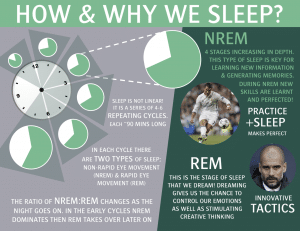
REM sleep is the stage of sleep that we dream and during this state our brain traces are very similar to that of being awake. However, during REM we have no muscle tone in our voluntary muscles which puts us in an immovable physical state (7). There are two main reasons why we dream, the first being a means of controlling our emotions and the second is to stimulate creativity and problem solving. During REM noradrenaline concentrations in the brain are completely shut off which places us in a more relaxed, stress-free state. This allows us to take the sting out of personal events that may be disturbing us and in turn heal us through a kind of mental therapy. Being a professional football player comes with a myriad of stresses and pressures ranging from being in the public eye 24/7 to competing in cup finals and relegation battles. If they do not give themselves adequate opportunity to process these emotions in their sleep then these pressures will quickly add up and start to manifest in their daily lives as mood swings, poor temperament on the pitch or even more harmful incidents damaging their public profile.
The American author John Steinbeck once said ‘A problem difficult at night is resolved in the morning when the committee of sleep has worked on it.’ Allied to this many of the most brilliant inventions and scientific discoveries have appeared to come to people whilst asleep. Whilst awake our thought processes tend to be more rigid and logical whereas during REM sleep it has been shown that we make more distant connections between different phenomena which are not typical. It is through this process that we can solve problems and come up with creative ideas. Besides providing another dose of mental and emotional counselling, regular doses of REM sleep have potential to re-invent team tactics and styles of play that are novel in the game. It would be entirely plausible to suggest that ‘Catennacio’, ‘Total Football’ and Barcelona’s approaches to the game had roots in the dreams of the patrons of these seminal tactical strategies.
Thomas Edison was a great believer in the creative capacity of dreaming. In fact, he would take a nap on a daily basis where we would relax in his rocking chair with a fist full of ball-bearings clenched in his hand. On the floor besides his chair there would be a turned over steel pot. Once he reached the REM state of sleep, his voluntary muscle tone in his hand would be lost and the ball bearings would hit the saucepan. The loud noise this made would be enough to wake him up and allow him to immediately write down any creative ideas that had come to him whilst dreaming.
Creative thinking aside, Thomas Edison was also onto something with the concept of napping. Despite the majority of us taking all of our sleep in one dose (monophasic) we are actually hard wired to take two doses of sleep per day (biphasic). Our hunter gatherer ancestors would take one extended period of sleep at night (seven to eight hours) followed by a 30-60 minute nap early afternoon. Genetically, we are programmed to experience a lull mid-afternoon (post-prandial dip). However, due to the necessity to work many of us resist the urge to sleep and seek artificial means to stay alert such as caffeine. This can negatively impact our quality of slumber later on and in turn results in a vicious cycle of poor sleeping patterns. Many professional clubs now have sleep pods or bedrooms at the training ground to accommodate a mid-afternoon nap. From a performance perspective this can kick start the recovery processes from the previous session but also may prepare us for the next training session. Specifically, the greatest pulse of growth hormone is released post-exercise and 1 hour into sleep (8). Structuring a 60 minute nap around a resistance training session may therefore enable a more anabolic environment to drive muscular adaptations. Hence, ditch the coffee and hit the pillow!
Maintaining the optimum body composition for a footballer is vital for maximising performance as well as preventing injuries. Fluctuations in body composition should be avoided; however, in some instances they are difficult to side-step. In particular, during long-term injury where a loss of lean muscle mass and a gain in fat mass is very common. Recent research looking at the influence of sleep on the effectiveness of diet found that the quality of sleep determined the type of weight the participants lost. Specifically, shorter sleep (5.5 hours per night) resulted in 70% of mass being lost through lean muscle mass compared to longer sleep (8.5 hours per night) where 50 % of mass was lost from fat sources. The desired retention of lean muscle mass shown here would suggest that injured players should be given the opportunity to maximise their sleep and from a practical perspective rehabilitation schedules could be fit around the players sleeping habits.
Sleep deprivation has also been shown to interfere with the hormones that control appetite; Leptin and Ghrelin (9). Leptin makes you feel full whereas ghrelin makes you feel hungry. Lack of sleep has been shown to stop Leptin production and increases levels of ghrelin, which, in combination, drives you to eat more. Hence, individuals who require dietary interventions need to ensure that (alongside accurate food diaries and macro-nutrient consumption) their sleep levels are strictly monitored. It is worth mentioning that being awake for longer does not justify the consumption of more calories. In fact, being awake for 24 hours compared to getting a normal night’s sleep only burns an additional 147 calories! What this proves is that sleep is indeed a very active process, which, considering all of the restorative benefits outlined above is not surprising.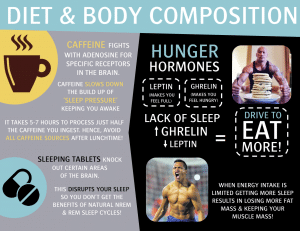
Unfortunately, many people may find it difficult to fall asleep and in turn are unable to capitalise on the benefits a good night’s sleep affords. Many features of a footballer’s schedule and in turn lifestyle can impact their sleep quality, more often than not these are factors that they cannot control. Alongside the travel complications identified earlier there is also playing late in the evening. For example, an 8 pm kick off will mean that a player is exercising until 10 pm in the evening and subsequently their body temperature will remain high for an hour or two beyond this. Body temperature is an additional circadian rhythm that keeps our sleep cycle in check, with a gradual drop in core temperature being important to transition into sleep. Evening matches therefore interfere with this process and will delay our onset of sleep. In order to compensate for this, players should be afforded a longer sleep the following morning so that they can still attain the recommended eight hours sleep. Bringing the squad in for a recovery session mid-morning or at lunchtime would be a good practical application. Keeping bedrooms at a cool temperature (~18°C) can also assist in creating the optimum environment.
In order to find a quick fix it is not uncommon for people who have difficulty sleeping to turn to sleeping pills and in some instances alcohol for assistance. The research suggests that this should be strongly avoided and in fact both of these approaches evoke brainwaves that are disrupted and unlike normal sleep (10). Alcohol is a sedative and unlike sleep it puts us into a state of anaesthesia. To process alcohol, our body produces ketones and aldehydes which act to prevent the brain from even going into REM sleep. Sleeping pills target receptors in the brain preventing certain electrical impulses to be fired and in turn this knocks out these areas of the brain inhibiting the benefits of natural sleep. Ultimately, you will wake up feeling groggy and sluggish if sleep is induced through these means as well as developing the risk of becoming dependant on them.
I hope that this blog has done enough to convince you of the value of sleep to the professional football player. It is something that, alongside some minor sacrifices can become one of your most powerful allies for unlocking your potential as a player.
But, don’t just take my word for it…
‘If I’m shooting for an ideal night of sleep, that’s somewhere between eight and 11 hours. But, I do nap. I am a professional athlete – my body is my job. And for my job, rest is so important.’ JJ Watt
‘If I do not sleep 11-12 hours a day it’s not right.’ Roger Federer
‘Eat, sleep and swim, that is all I can do.’ Michael Phelps
To purchase “Why We Sleep” by Matthew Walker click on this link https://footballscr.com//product/why-we-sleep/
References
- Walker, M. (2017). Why we sleep – The New Science of Sleep and Dreams. Penguin Books: Clays Ltd: St.Ives.
- Moore, M., & Meltzer, L.J. (2008). The sleepy adolescent: causes and consequences of sleepiness in teens. Paediatric.Respir.Rev., 9, 114-120.
- Van Dongen, H.P., Maislin, G., Mullington, J.M., & Dinges, D.F. (2003). The cumulative cost of additional wakefulness: dose-response effects on neurobehaviour functions and sleep physiology from chronic sleep restriction and total sleep deprivation. Sleep, 26, 117-126.
- Carskadon, M.A., & Dement, W.C. (2011). Normal human sleep: An overview. Principles and Practice of Sleep Medicine. M.H. Kryger, T.Roth, and W.C. Dement. St.Louis, Elsevier: 16-25.
- Ken Berger, ‘In multibillion-dollar business of NBA, sleep is the biggest debt’ (June 7, 2016), accessed at http://www.cbssports.com/nba/news/in-multi-billion-dollar-business-of-nba-sleep-is-the-biggest-debt/.
- Milewski et al., ‘Chronic lack of sleep is associated with increased sports injuries in adolescent athletes.’ (2014). Journal of Paediatric Orthopaedics, 34, 129-133.
- Halson (2013) Sleep and the elite athlete. Sports Science Exchange, 26, 1-4.
- Shapiro, C.M., Bortz, R., Mitchell, D., Bartel, P., & Jooste, P. (1981). Slow wave sleep: a recovery period after exercise. Science, 214, 1253-1254.
- Spiegel, K., Tasali, E., Penev, P., and Van Cauter, E. (2004). Brief communication: Sleep curtailment in healthy young men is associated with decreased leptin levels, elevated ghrelin levels, increased hunger and appetite. Ann.Intern.Med., 141, 846-850.
- Arbon, E.L., Knurowska, M., Dijk, D.J. (2015). Randomised clinical trial of the effects of prolonged release melatonin, temazepam and zolpidem on slow wave activity during sleep in healthy people. Journal of Psychopharmacology, 29, 764-776.
